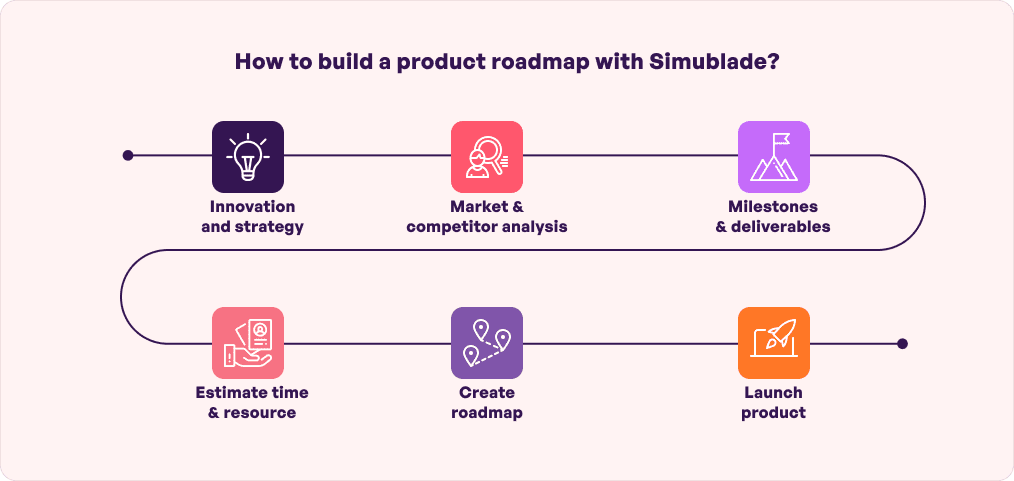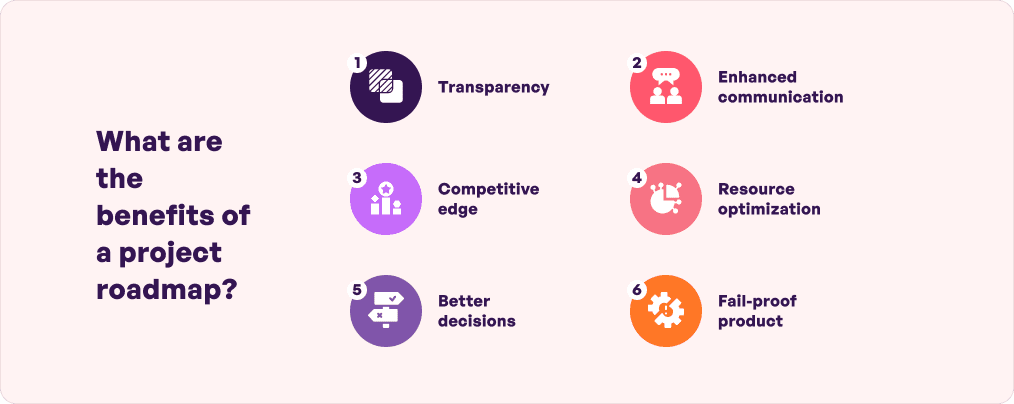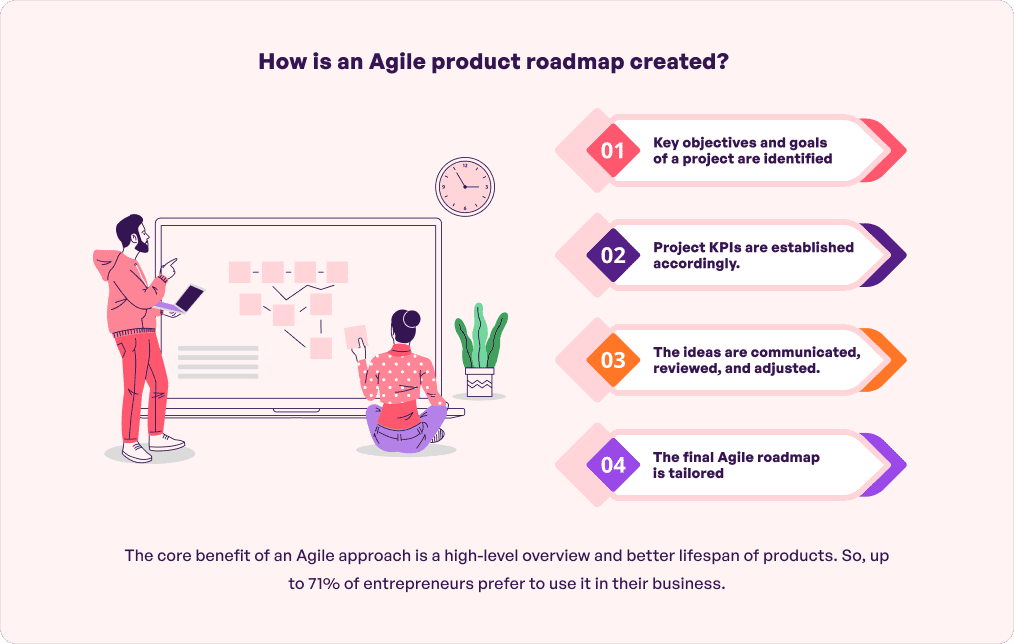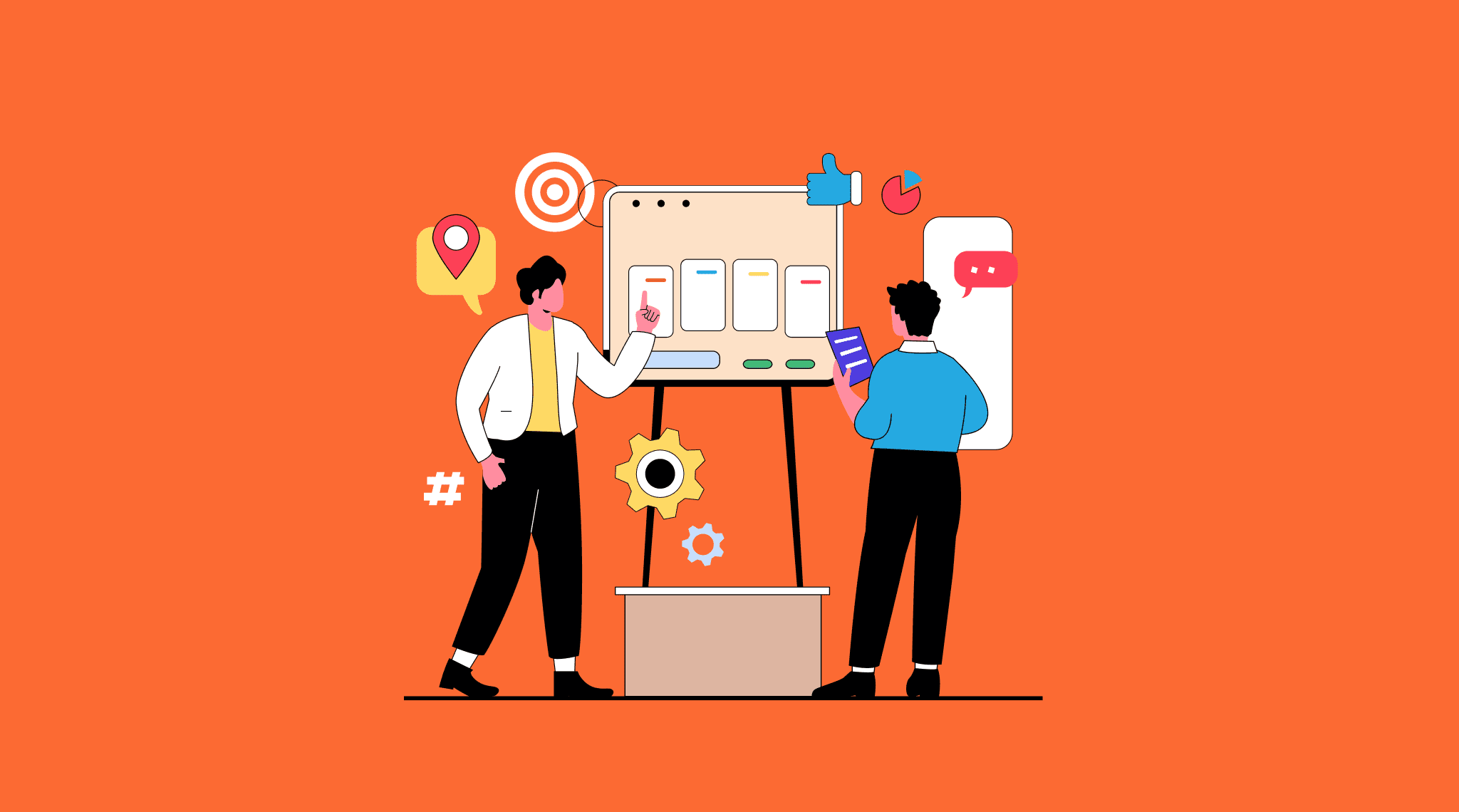Smartphones today have come a long way with AI, GPS, payment, cameras, biometric management, wearable integrations, and holographic displays. They have deeply penetrated our lives with apps that revolutionize communication, information, and entertainment, and have more futuristic possibilities. The outcome? Well, a Pew Research Center survey confirms that 9 in 10 Americans, which is 90% of the US population, own a phone in 2024, up from just 35% in 2011. Tapping on to even a percentage of this segment can enhance your business profitability and prestige. The best way to do so is to craft an efficient app with innovation-first features to boost market adoption. But how to get started?
This is when a well-strategized product roadmap is invaluable. It is a multi-step procedure that offers a glimpse into the long-term and short-term visions and directions of the app along with a concrete idea to achieve them. This eases the development and assures the minimum risks of failure. Let us learn and understand it in detail to make an informed choice.
Table of contents
What is a product roadmap for app development?
This is a standard blueprint of a mobile app development process containing inspirations, purposes, objectives, initiatives, priorities, and a solid action plan. It can be used to understand how the product will grow and shift with opportunities and changing needs. In short, the product roadmap answers three questions: why, what, and when?
This is where we, at Simublade, can be your dedicated partner to cater to these queries and create a roadmap for an Agile development process that transforms your business. Our technical strategies and design-thinking approach help in building go-to solutions.
 We treat the roadmap like a mandate and ensure a proper discovery workshop session to invent and reimagine your digital dream and then deliver frameworks to enhance revenue streams. All of these are typically well-documented to help align the marketing team, sales teams, product teams, and the stakeholders.
We treat the roadmap like a mandate and ensure a proper discovery workshop session to invent and reimagine your digital dream and then deliver frameworks to enhance revenue streams. All of these are typically well-documented to help align the marketing team, sales teams, product teams, and the stakeholders.
The overall time taken to build a roadmap can be for 2 weeks or a little longer. However, outsourcing it to a trusted company like us, offering product strategy services, is a smart move if you wish to save time without compromising on the efficiency. With us, businesses can also rest assured that their end-users will enjoy a friction-free experience with our product roadmap approach.
What are the benefits of an app development roadmap?

1. Transparency
The top advantage is the transparency it offers in mobile app development. Be it the MVP tech stack, UI/UX design, branding, themes, cybersecurity, or the languages and frameworks to be used, the roadmap encapsulates these factors to turn siloed ideas into reality.
2. Enhanced communication
A roadmap for app development is never stuffed with details. Instead, it contains essential information which :
- acts as a point of reference
- helps understand the status of progress, and
- allows proper communication regarding different verticals.
Real-time analytics foster on-time discussions which creates a collaborative space. Older versions of the roadmap are also referred to from the archive to understand which pending tasks have been ticked-off and what needs to be re-prioritized or canceled.
3. Competitive Edge
Well-structured roadmaps promise relevance in terms of milestones, components, and timelines. The developers further evaluate the industry landscape and competitor insights to stay ahead in the game, while ensuring a linear growth and development towards the end-goal with minimum risks and challenges and zero chances of failures. Overall, the roadmap provides a fantastic competitive edge.
4. Resource optimization
The best roadmaps for mobile app development have clear steps with a high-level overview of the deliverables, budget, and timelines. Further, these are updated from time to time to create a sync with the current business ecosystem since the roadmap that works around these pre-decided plans which lower the risks of financial and human resource wastages.
5. Better decisions
A roadmap outlines how the end-product will turn out to be in compliance with the goals and objectives of your business. There is a comprehensive understanding laced in strategy and execution that helps leaders make informed decisions. It leads to zero chaos since each individual in the process has a discrete ownership. So, better choices can be made before kick-starting the project and tweaking requirements in the ongoing journey.
6. Fail-proof product
Ultimately, the result is a fail-proof, innovative, and advanced product that enjoys market viability. This ensures satisfaction for potential investors and users, while with a ready roadmap, business can also focus on analyzing how to upgrade from current successful products which keeps them ahead in the competitive race.
 What are the different product roadmap development tools?
What are the different product roadmap development tools?
The product roadmap software market is valued at $1.3 billion in 2024 and is predicted to reach a whopping $2.5 billion by 2031 at 7% CAGR. Curious to know why? Well, the best tools aid in speed and efficiency, ensuring high-level strategic view, consistent planning, better task prioritization, generating accurate reports and analytics, monitoring customer behavior patterns, and refining ideas and adding features and requirements.
Let us see the list of tools that the best developers use.
- Visor
- ClickUp
- Miro
- FigJam
- airfocus
- ProductPlan
- Nifty
- Reveall
- Productboard
- Trello
- Asana
- Aha!
- Jira
However, used incorrectly, these can affect the flow, milestones, and learning. This can cost businesses their precious time and money. You might also end up losing investors since the end-product functionalities could be derailed from worn usage of the tools.
The best way to optimize them is relying on expert developers. Our mobile app development company in Texas offers a team that lives and breathes technologies. They are well-versed with the roadmapping process and keep research, next-gen tech-stack, and innovation in the center of business continuity. You can further expect detailed user persona, competitor analysis, and business mapping documents included in the deliverables.
What are the steps to create a product roadmap for an app development process in Simublade?
At Simublade, our roadmap strategy is a comprehensive one. From intention to results – we assist right from the start of the journey till the end and beyond. This has successfully helped us create one of our star products Tavus, a platform for personalized AI-powered videos, which is now a multi-million funded company. Keep reading to delve deep into our roadmapping process.
Step 1: Business understanding
We analyze your organization from several angles keeping market trajectories, end goals, user persona, competitors, and technological ecosystem in mind. This data helps us get started with charting digital-first product versions.
Step 2: Gap analysis
This is where we identify areas that must align with a product’s development strategy to match with the bigger picture, that is, the business goal. It is applicable in both cases – if you are an established business or even a startup that already has a digital product in place.
When we find gaps, we dig deeper into an analysis and create a document containing which elements are missing and need to be incorporated into the product roadmap.
Step 3: Plan & roadmap creation
We take the hypothesis testing and execution and create a detailed roadmap around it. This will also include predicted potential competitive landscape shift, modification ideas for planned features, and specific adjustments as per customer preferences. We help you get an idea of what your software is capable of doing alongwith creating a system where the entire process is documented for the reference of stakeholders to maintain transparency.
Step 4: Execution
This stage is when we build a product roadmap for app development using the Agile development methodology. Businesses can see us in action as we put every digital product requirement into the sprint. This is done by considering data, inputs, and feedback from your business to craft a digital-friendly solution. The entire process is completed within the least possible time to confirm the software development work begins on time, which ultimately helps to go live in the market before competitors come into the picture.
Step 5: Monitoring & results mechanism
Like we promised, our product roadmap for app development is an end-to-end process- from idea to post launch growth. So, we help with digital product development from scratch and monitor the performance and progress once it is launched.
Since Simublade is an expert with Agile roadmaps, let us explore further into it.
What are the different types of Agile app development roadmaps that are used in Simublade?
Any project that runs on the Agile has a 64% success rate. This is because the central theme of the method is flexibility, which means, changes can be made even at the last minute without disruptions. The Agile approach also offers better communication between the business and developers which provides better control over the project.
 Needless to say, these are the reasons why our developers trust this software development process for high-level project plans.
Needless to say, these are the reasons why our developers trust this software development process for high-level project plans.
There are two types of Agile roadmap development process based on business needs. Here’s a detailed idea of each.
Time-based roadmap development
Hire developers who can create a pictorial representation to communicate how the business product will transform over time. This can be weeks, months, quarters, and even years. It helps set clear expectations of how long the company will focus on particular initiatives and when the different task deadlines are to be met. Time-based roadmaps are typically in the form of grids and barcharts. .
Outcome-based roadmap development
Developers define the goals, track the progress, and monitor if the right steps are being followed as per the desired result. They will prioritize the progress on impactful features and initiatives over the predetermined deadlines set for the process. This entire method is represented via a Kanban-like board which uses cards, lists, columns, and tech-stacks to help developers commit to doable work.
A few different types of roadmap structures that developers can follow are Portfolio, Epics, Release, and Features Roadmaps. Here’s a breakdown:
Portfolio roadmap: This is a planned outline of the roadmap for several products that are in the business portfolio. It will include the development schedule and the launch plan.
Epics roadmap: This is a visualization of different initiatives broken into smaller parts and set against their timelines. However, all of the fragments are connected to the end-goal.
Release roadmap: Cross-functional launches and release activities are coordinated in this process so every individual is able to see what to be done when.
Features roadmap: Developers create a visual timeline of their work and delivery. A detailed view of different improvements and added functionalities are included here.
 What mistakes to avoid when developing mobile app development roadmaps?
What mistakes to avoid when developing mobile app development roadmaps?
A product roadmap makes sure every individual in the process is united and is headed towards the same direction to produce the planned outcome. Learn a few mistakes that can be avoided with specific solutions to help you maximize its capabilities.
Overstuffing with features
Try not to do so since it strips focus off the essential ones, sets high-end expectations, and delays the delivery. The entire project also somehow turns out to be overambitious trying to achieve several milestones at once. So, pick features that are critical, at least for the MVP development or the initial product, and make sure they are making it to the roadmap. Else, the entire effort could be rendered worthless by stakeholders.
Agreeing to every request
Investors, employees, or partners might want to include particular features in the roadmap that work in their interest. You, as the business owner, have to check if they lead to business success. If not, then they need to be eliminated since unnecessary features do not make a roadmap efficient. It will not be able to capture the essence of the product and maintain the uniqueness – something that is your USP among fellow brands. This can lower the rate of market adoption.
Ignoring all the feedback
It is not a good idea to disregard feedback completely. Else, the product might not resonate with the customers at all thus leading to poor reputation and revenue. So, although you do not have to agree to everything, consider a careful analysis of possible concerns of customers, stakeholders, and team members. Allow them to share risks and confusions that might come up and try to get answers to address them.
Creating a fixated roadmap
Build a product roadmap for app development that can be fine-tuned when required. Otherwise, businesses are less likely to meet the changing demands as per trends, economic conditions, and customer pain-points. Company goals might also be compromised if there is no way to make upgrades or downgrades, whenever.
Do assess the roadmap at least thrice a month and keep rooms for flexibility to stay updated to the current industry standards and business environment.
What are best practices to build a mobile app development roadmap?
In collaboration with developers and their design sprint services, here’s how businesses ensure the best practices for a fruitful and worthy product development roadmap. Know that these are the practices that help achieve meaningful results.
- Include elements like colors, symbols, hierarchy, timelines, and growth.
- Seek perspectives from multiple sources like collaborators, business partners, existing customers, and colleagues.
- Organize tasks and emphasize on the important ones.
- Adjust dates and plans when needed instead of displaying rigidity.
- Keep the lines of communication open with every person who is involved.
- Set a few success metrics to be able to be in-line with the progress.
In conclusion, a product roadmap is an extremely important step in software development. To ensure you do not mess it up, work side by side with us at Simublade. We take real feedback from users to assure market acceptance and help turn your concept into a viral digital solution.
FAQs
Q. How much time does it take for a product roadmap for app development?
Ans. App development roadmap can take 2 weeks or longer. Get in touch with Simublade, a company that takes pride in their discovery workshop and roadmap strategy, to get a better understanding of the timeline.
Q. Which development methodology is used in roadmaps for mobile app development?
Ans. As a part of Simublade’s digital product strategy service offering, we use the Agile methodology which has helped us deliver highly quality end-results. Other popular ones in the market are Waterfall or hybrid models.





